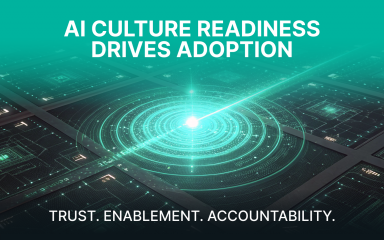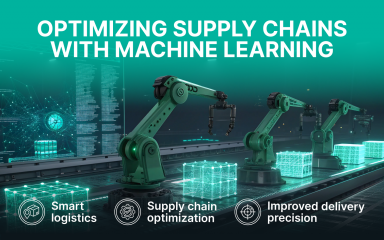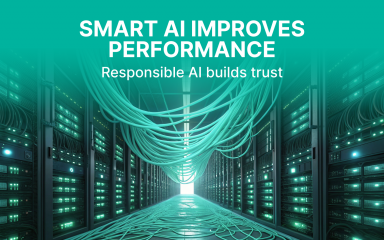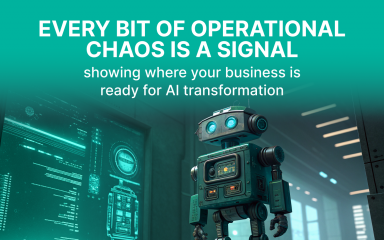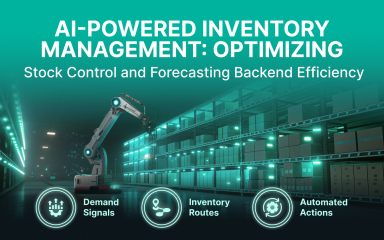An enterprise AI strategy isn’t just another IT initiative; it’s the blueprint for how companies will innovate, grow, and stay competitive in 2025. Without it, AI projects risk becoming flashy pilots that never scale. With it, organizations turn artificial intelligence into a reliable engine for measurable value.
This article breaks down what that strategy really means, how to build the right framework, and the practical steps enterprises can take to move from experiments to impact.
What Is an Enterprise AI Strategy?
An enterprise AI strategy is a structured plan that guides how a company adopts, develops, and manages AI at scale. Think of it as the connective tissue between your business strategy and the technology itself. It defines priorities, sets guardrails, and ensures AI initiatives serve clear business objectives rather than becoming side projects.
Why does this matter in 2025? Because ad-hoc AI use, plugging in tools without a long-term view, quickly creates silos, compliance risks, and wasted spend. A proper AI strategy for the enterprise treats artificial intelligence as a core capability, not a side hustle. And an AI-driven enterprise strategy sets you up for transformation, not just one-off wins.
Enterprise AI in 2025: Key Statistics and Trends
If you need proof that AI is no longer optional, just follow the money. While overall IT budgets are growing at about 2% this year, AI spending is rising nearly 6%, driven largely by generative AI. Two-thirds of enterprise teams are preparing to invest between $50 million and $250 million in GenAI over the next year, with total spending expected to hit $644 billion in 2025.
Adoption rates are also high: 78% of enterprises already use AI, and half of them deploy it across multiple departments. Most projects (92%) move from pilot to deployment within a year. The ROI is promising: companies report an average of $3.50 in value for every $1 invested. Still, results vary: 74% of mature adopters see solid returns, while 60% of others struggle to break 50% ROI.
The lesson? Strategy makes the difference. Enterprises with a formal AI strategy succeed 80% of the time, compared to just 37% for those experimenting without a roadmap. With the enterprise AI strategy 2025 market projected to reach $38.19 billion in 2025 and grow at a CAGR of 52% through 2033, the pressure is on. The winners will be those who align AI initiatives with business goals, enforce governance, and secure executive buy-in, turning pilots into sustained impact.
Building the Enterprise AI Strategy Framework
A solid enterprise AI strategy framework answers a simple question: how do you scale AI without chaos? Instead of chasing shiny tools, it lays out clear enterprise AI strategy steps that connect vision, data, people, and technology.
In 2025, building an effective framework is about a structured, enterprise-wide approach that ties AI directly to business objectives and capabilities. Here’s what a comprehensive framework includes.
Vision & Objectives
Every AI journey starts with clarity. What’s the actual target: improving customer satisfaction, cutting costs, or discovering new business opportunities? Retailers may use AI for inventory management, while manufacturers might prioritize predictive maintenance. Without aligning AI projects to business goals, even the smartest algorithms miss the point.
Defining vision means engaging C-level executives and business units early. AI only works when leadership commits and measurable outcomes are tied to it. SMART goals (Specific, Measurable, Achievable, Relevant, Time-bound) tied to clear key performance indicators give everyone the exact definition of success.
Data & Infrastructure
AI runs on both structured and unstructured data. Without data quality, data governance, and an accessible data infrastructure, no machine learning models can perform. Enterprises should treat data management like fuel storage: secure it, refine it, and ensure it flows where it’s needed.
The first step is a current state assessment. Audit your historical data assets for compliance (think GDPR or HIPAA), availability, and accessibility. Then evaluate infrastructure readiness: cloud platforms, compute power, and existing enterprise AI platforms. Without a strong data backbone, AI adoption is impossible to scale.
Talent & Governance
Even the best models collapse without relevant teams and clear rules. Successful companies build AI expertise in-house while enforcing responsible AI policies to cover regulatory compliance and legal risks. Reskilling existing staff and hiring data scientists or ML engineers are often necessary.
Governance is more than paperwork, because it’s about accountability. Assign ownership to compliance officers, risk committees, and executive sponsors. Create playbooks for ethical use, bias mitigation, and data privacy. These foundations turn fragile projects into durable systems.
AI Model Lifecycle
From experimentation to deployment, AI models follow a lifecycle: collect training data, run model training, test, and move to production. Treat this as a loop, not a straight line: models drift, new sales data comes in, and retraining is inevitable.
The lifecycle must also include design decisions: build vs. buy, open-source vs. enterprise-grade. And in 2025, emerging approaches like generative AI, edge AI, and hyper-automation are part of the design conversation.
Deployment & Integration
A strategy only matters if it shows up in daily work. AI implementation should integrate into existing business processes, such as CRM, enterprise software, and logistics, without breaking workflows.
That means prioritizing use cases not only by ROI potential but also by feasibility. Quick wins, like virtual assistants for support or automation of repetitive back-office tasks, create momentum while long-term transformations (like supply chain optimization) are built in parallel.
Monitoring & Observability
Enterprises need enterprise AI applications that are not only built but also monitored. That means setting key performance indicators, tracking for bias, and maintaining feedback loops. Observability keeps AI systems accurate, compliant, and trustworthy.
Dashboards, alerts, and analytics tools must be part of the core AI strategy for the enterprise. This ensures decision makers get valuable insights on performance and adoption, while allowing AI solutions to evolve alongside changing operational processes and industry regulations.
Recommended Development Process
To bring the framework to life, most experts suggest a structured rollout:
- Discovery & Assessment – Audit current capabilities, pain points, and data assets.
- Strategic Roadmap Development – Build a roadmap with clear KPIs, timelines, and resources aligned to outcomes.
- Solution Design & Deployment – Develop or integrate AI solutions, test thoroughly, and ensure reliability.
- Scaling & Optimization – Expand successful pilots across the enterprise and embed AI in core workflows.
- Governance & Risk Management – Put guardrails in place to ensure ethical AI development and compliance.
- Measurement & Evolution – Continuously refine models, update processes, and realign to evolving business requirements.
In summary, a comprehensive enterprise AI strategy framework moves AI from an isolated experiment to a core business capability. Yet despite near-universal investment, only 1% of leaders call their organizations truly mature in AI deployment. Employees are ready, often more than leaders realize, but the bottleneck is executive direction. McKinsey estimates up to $4.4 trillion in productivity gains, but capturing it requires bold leadership, clear alignment with business goals, and responsible governance. Moving too cautiously risks missing the AI wave, just as some companies once missed the internet.
Enterprise AI Implementation: From Strategy to Deployment
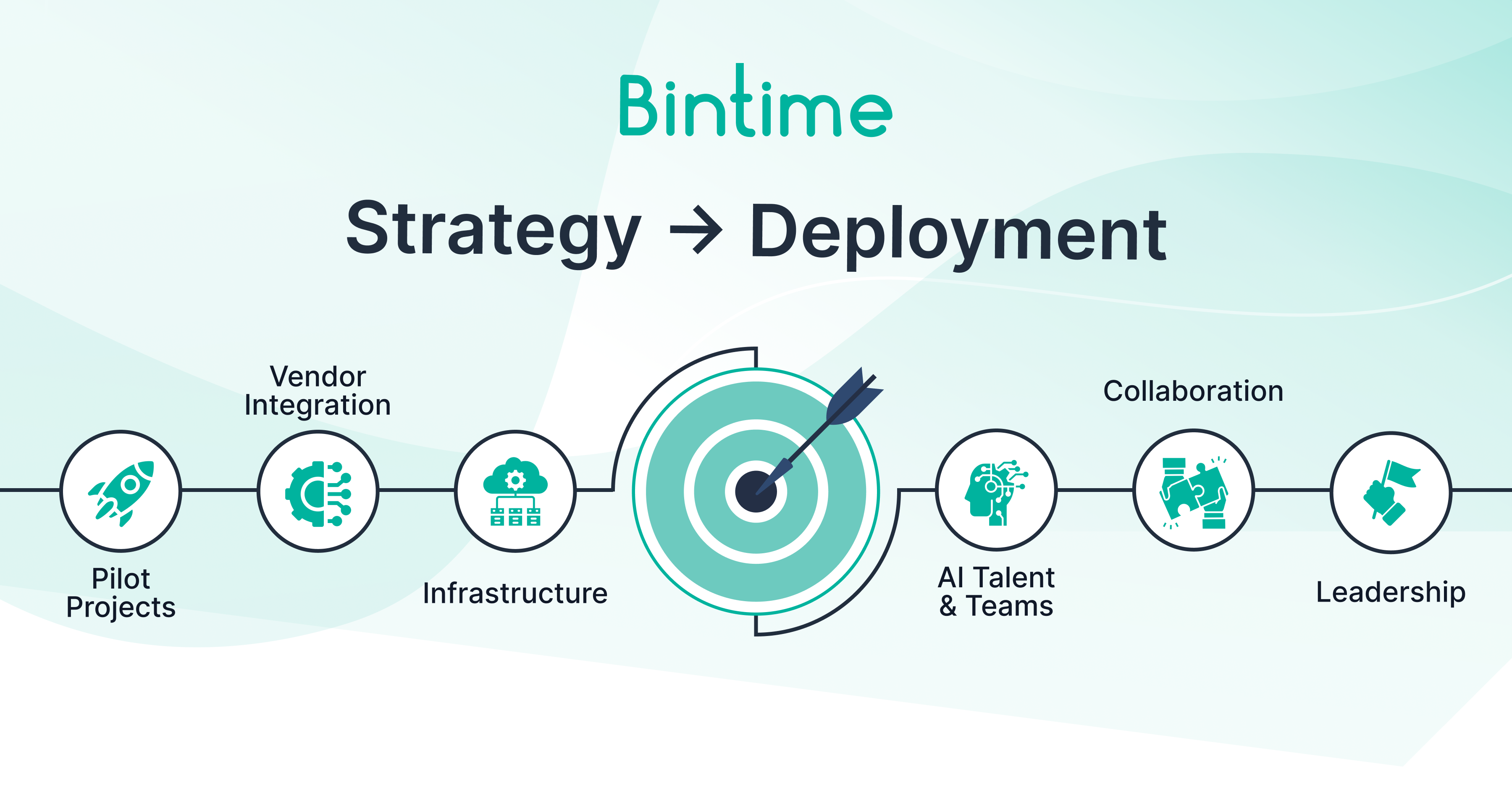
A framework is only useful if it leads to action. That’s where an enterprise AI implementation strategy comes in, moving from ideas on paper to real-world deployments. Think of it as translating vision into practice, step by step. A strong enterprise AI deployment strategy ensures pilots grow into enterprise-wide systems rather than stalling out in experiments.
Pilot Projects & Proof of Concept
Start small, but start smart. Pilot projects act as low-risk test beds to prove business value before scaling. For example, a retailer might deploy AI applications to optimize pricing on a single product category. An insurance firm might test predictive maintenance models on a fleet of company vehicles. These pilots validate assumptions, reveal hidden risks, and build trust with leadership. Done right, they create a roadmap for scaling across departments.
Vendor Integration
Few companies build everything themselves. Partnering with the right vendors accelerates time-to-value. But selection matters: look for providers with strong compliance track records, proven AI platform flexibility, and integration support for your existing enterprise stack. Vendor integration isn’t just plug-and-play; it’s a strategic decision that affects governance, security, and scalability.
Cloud Stack & Infrastructure
AI needs serious horsepower. That’s why scalable infrastructure is non-negotiable. Cloud-native architectures support machine learning models, deep learning frameworks, and generative AI services with on-demand resources. The right stack balances cost efficiency with performance, blending cloud, edge, and hybrid environments depending on use case. A solid infrastructure means your pilots don’t crumble when scaled enterprise-wide.
AI Talent and Organizational Alignment
No matter how sharp your strategy, it will collapse without the right people. An enterprise talent strategy with AI ensures teams have the skills, culture, and leadership to make AI stick. Success here is less about algorithms and more about people alignment.
Building AI-Ready Teams
Companies need more than data scientists: they need hybrid teams. Business analysts, engineers, and domain experts all contribute. Reskilling programs help existing employees adapt, while new hires bring specialized AI expertise. Forward-thinking firms also experiment with human agents working alongside virtual assistants, building confidence in AI-enhanced workflows. This is the heart of AI in enterprise talent strategy.
Cross-Functional Collaboration
AI works best when silos break down. Data teams, legal, compliance, and business units need to share responsibility. That means co-designing AI solutions where technical models directly address frontline challenges, from sales data analysis to customer relationship management. Collaboration ensures that AI isn’t a side project but a partner in daily business processes.
Leadership & Change Management
Leadership is the linchpin. Without top-down sponsorship, AI projects stall. Leaders must champion why the effective AI strategy matters, connect it to business value, and model transparency around change. A strong culture of experimentation, accountability, and communication is the difference between adoption and resistance.
Best Practices for Enterprise AI Strategy
Insights from leading companies highlight that the strongest enterprise AI strategy best practices are about governance, collaboration, and iteration. These AI strategy best practices enterprise recommendations help organizations scale responsibly.
Governance & Compliance
From responsible AI to ethical AI development, governance is the backbone. Compliance with industry regulations, transparency in AI use, and strong data governance frameworks keep AI safe, fair, and trusted. Ignoring this is a reputational time bomb.
Vendor Partnerships
AI isn’t a solo effort. Strategic partnerships with vendors, consultants, and cloud providers give enterprises access to AI technologies, pretrained models, and compliance expertise. The trick is balance: use external knowledge to accelerate without becoming dependent.
Continuous Improvement
AI isn’t a “deploy once and forget” system. Models drift, data changes, and regulations evolve. Companies must constantly monitor, retrain, and adjust AI features and operational processes. A living strategy is what sustains long-term value creation.
Enterprise AI Observability & Optimization
AI maturity requires oversight. An enterprise AI observability strategy ensures models stay accurate, compliant, and effective over time.
Monitoring Model Performance
Define key performance indicators from day one: accuracy, latency, cost savings, and business impact. Continuous monitoring catches issues like model drift, poor training data, or compliance gaps. Without measurement, scaling is a gamble.
Feedback Loops
Real-world feedback keeps AI grounded. Whether it’s historical data, unstructured data, or user interactions, feedback loops refine AI application quality. The result? Smarter models, better decision-making, and higher customer satisfaction.
The Role of Consultants in Enterprise AI Strategy Development
Sometimes internal teams can’t do it all. That’s where enterprise AI value strategy consultants come in: helping enterprises accelerate adoption, avoid pitfalls, and embed best practices.
When to Bring in Consultants
Call in external help when AI projects stall, governance questions multiply, or ROI remains elusive. Consultants help identify data readiness gaps, restructure business operations, and align AI with business requirements.
How Consultants Add Value
Consultants shorten the learning curve. They bring pre-tested frameworks, benchmark insights, and cross-industry expertise. Whether guiding AI implementation, evaluating AI investments, or shaping AI adoption, they help enterprises turn strategy into outcomes.
Flexible AI Strategy FAQ
What is the difference between tactical AI adoption and a full enterprise AI strategy?
Tactical adoption solves one-off problems. A full enterprise AI strategy aligns AI across workflows, making it part of the AI strategy for the enterprise. The difference is short-term impact versus long-term transformation.
How long does it take to implement an enterprise AI strategy?
Most organizations need 12–24 months. A phased enterprise AI implementation strategy begins with pilots, scales through proof of value, and evolves into a full enterprise AI adoption strategy.
Do all enterprises need AI governance frameworks?
Yes. Without governance, risks multiply. Following enterprise AI strategy best practices and building an AI strategy best practices enterprise framework protects compliance, ethics, and trust.
Can AI strategy help future-proof an organization?
Absolutely. An enterprise AI transformation strategy paired with an AI-driven enterprise strategy gives companies adaptability, resilience, and lasting competitive advantage.
What role do consultants play in developing an enterprise AI strategy?
Enterprise AI value strategy consultants fill skill gaps, accelerate scaling, and reduce risks in AI implementation. They ensure enterprises extract measurable business value faster.
What are common mistakes when creating an enterprise AI strategy?
Skipping the enterprise AI strategy framework, neglecting governance, underinvesting in talent, and ignoring data silos are the usual culprits. The cure? Structure, leadership, and accountability.
What’s Next?
The future belongs to enterprises that treat AI as strategy, not an experiment. A strong enterprise AI strategy connects vision, data, talent, and governance to create measurable impact. The risk isn’t in aiming too high; it’s in aiming too small.
Curious how this could look in practice? Request a personalized consultation with our Partner Manager to explore how we can help you build and scale your AI strategy.

